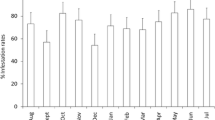Abstract
Pine wood nematode (Bursaphelenchus xylophilus), one of the most destructive invasive species, has caused extremely serious economic, ecological and social losses in many countries throughout the world. Since the high reproductive rate of B. xylophilus PWN is the main cause of rapid death of its pine hosts (Pinus spp.), understanding the reproductive and population biology and the ecology of this nmatode are of great importance. This study mainly focused on analyzing the mating process and population structure under different combinations of sex ratios for mating. Reproductive efficiency of B. xylophilus peaked when the sex ratio (female to male) was 3.4:1. Phases of the mating process for the different sex-ratio combinations indicated that B. xylophilus had evolved alternative reproductive strategies to cope with complex copulating conditions to obtain a suitable population structure for further propagation. This research provides fundamental information on the mechanism that is responsible for the rapid population growth of B. xylophilus.


Similar content being viewed by others
References
Álvarez OA, Jager T, Kooijman SALM, Kammenga JE (2005) Responses to stress of Caenorhabditis elegans populations with different reproductive strategies. Funct Ecol 19(4):656–664
Brown AM (2005) A new software for carrying out one-way ANOVA post hoc tests. Comput Methods Programs Biomed 79(1):89–95
Cheng XY, Xie PZ, Cheng FX, Xu RM, Xie BY (2009) Competitive displacement of the native species Bursaphelenchus mucronatus by an alien species Bursaphelenchus xylophilus (Nematoda: Aphelenchida: Aphelenchoididae): a case of successful invasion. Biol Invasions 11(2):205–213
Cui J, Li YX, Zhang W, Wang X, Pan L, Feng YQ, Zhang XY (2020) The population structure and sex ratios of Bursaphelenchus xylophilus under α-pinene stress. J For Res 31(3):921–926
Futai K (2013) Pine wood nematode, Bursaphelenchus xylophilus. Annu Rev Phytopathol 51(51):61
Johnt J, Maurice M, Manuel M, Hongmei LI, Taisei K (2010) Bursaphelenchus xylophilus: opportunities in comparative genomics and molecular host-parasite interactions. Mol Plant Pathol 9(3):357–368
Jung J, Han H, Ryu SH, Kim W (2010) Microsatellite variation in the pinewood nematode, Bursaphelenchus xylophilus (Steiner and Buhrer) Nickle in South Korea. Genes Genom 32(2):151–158
Katsuyama N, Sakurai H, Tabata K, Takeda S (1989) Effect of age of post-feeding twig on the ovarian development of Japanese pine sawyer, Monochamus alternatus. Res Bull Fac Agric Gifu Univ 54:81–89
Kiyohara T, Suzuki K (2010) Nematode population growth and disease development in the pine wilting disease. For Pathol 8(5–6):285–292
Liu BJ, Hu JF, Liu ZY, Xu L, Lu Q, Li YX, Zhang XY (2014) Behavioural features of Bursaphelenchus xylophilus in the mating process. Nematology 16(8):895–902
Maehara N, Futai K (1997) Effect of fungal interactions on the numbers of the pinewood nematode, Bursaphelenchus xylophilus (Nematoda: Aphelenchoididae), carried by the Japanese pine sawyer, Monochamus alternatus (Coleoptera: Cerambycidae). Fundam Appl Nematol 20(6):611–617
Mamiya Y (1972) Pine wood nematode, Bursaphelenchus lignicolus Mamiya and Kiyohara, as a causal agent of pine wilting disease. Rev Plant Prot Res 5:46–60
Mamiya Y (1983) Pathology of the pine wilt disease caused by Bursaphelenchus xylophilus. Annu Rev Phytopathol 21(21):201–220
Mamiya Y, Shoji T (2009) Pathogenicity of the pinewood nematode, Bursaphelenchus xylophilus, to Japanese larch, Larix kaempferi, seedlings. J Nematol 41(2):157–162
Mota MM, Vieira P (2008) Pine wilt disease: a worldwide threat to forest ecosystems. Springer, Netherlands, pp 5–14
Niu HT, Zhao LL, Lu M, Zhang S, Sun JH (2012) The ratio and concentration of two monoterpenes mediate fecundity of the pinewood nematode and growth of its associated fungi. PLoS ONE 7(2):e31716
Plaistow SJ (2004) Evolution of alternative mating tactics: conditional versus mixed strategies. Behav Ecol 15(4):534–542
Pröhl H (2002) Population differences in female resource abundance, adult sex ratio, and male mating success in Dendrobates pumilio. Behav Ecol 13(2):175–181
Scheiner SM (1993) Genetics and evolution of phenotypic plasticity. Annu Rev Ecol Syst 24(1):35–68
Schlichting C, Pigliucci M (2010) Phenotypic evolution: a reaction norm perspective. Am J Phys Anthrop 109(1):144–146
Shinya R, Morisaka H, Takeuchi Y, Futai K, Ueda M (2013) Making headway in understanding pine wilt disease: what do we perceive in the postgenomic era? J Biosci Bioeng 116(1):1–8
Shinya R, Chen A, Sternberg PW (2015) Sex attraction and mating in Bursaphelenchus okinawaensis and B xylophilus. J Nematol 47(3):176
Smith JM (1978) The evolution of sex. Nature 324:300–301
Smith JM (1982) Evolution and the theory of games. Cambridge University Press, Cambridge, p 41
Tomkins JL, Hazel W (2007) The status of conditional evolutionarily stable strategy. Trends Ecol Evol 22(10):522–528
Triantaphyllou A (1973) Environmental sex differentiation of nematodes in relation to pest management. Annu Rev Phytopathol 11(1):441–462
Vincent B, Altemayer V, Rouxmorabito G, Naves P, Sousa E, Lieutier F (2008) Competitive interaction between Bursaphelenchus xylophilus and the closely related species Bursaphelenchus mucronatus. Nematology 10(2):219–230
West-Eberhard MJ (1989) Phenotypic plasticity and the origins of diversity. Annu Rev Ecol Syst 20:249–278
Williams CG (2006) Landscapes, genomics and transgenic conifer. Springer, Netherlands
Zhao LL, Sun JH (2017) Pinewood nematode Bursaphelenchus xylophilus (Steiner and Buhrer) nickle, pp 3–21
Zhao BG, Futai K, Sutherland JR, Yuko T (2008) Pine wilt disease. Springer, Japan
Zhao LL, Mota M, Vieira P, Butcher RA, Sun JH (2014) Interspecific communication between pinewood nematode, its insect vector, and associated microbes. Trends Parasitol 30(6):299–308
Author information
Authors and Affiliations
Contributions
XZ, ZL, JH designed the study; YL, MG, BL, XW performed the experiments and analyzed the results; YL, MG wrote the manuscript. All authors read and approved the manuscript.
Corresponding authors
Additional information
Publisher's Note
Springer Nature remains neutral with regard to jurisdictional claims in published maps and institutional affiliations.
Project funding: This work was funded by the National Key R & D Program of China (2018YFC1200400).
The online version is available at http://www.springerlink.com.
Corresponding editor: Tao Xu.
Rights and permissions
About this article
Cite this article
Li, Y., Gao, M., Liu, B. et al. Mating and reproductive characteristics of the pathogenic nematode Bursaphelenchus xylophilus. J. For. Res. 32, 1281–1286 (2021). https://doi.org/10.1007/s11676-020-01150-6
Received:
Accepted:
Published:
Issue Date:
DOI: https://doi.org/10.1007/s11676-020-01150-6




